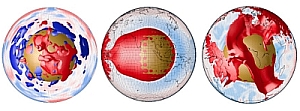The interdisciplinary nature of CEED provides an ideal research environment for multi-system numerical models. Using inputs from a great diversity of disciplines, including geology, physics, mathematics, chemistry, palaeoclimatology, palaeontology, tectonics, palaeomagnetism, geodynamics, seismology, mineral physics, planetology and atmospheric sciences, CEED researchers want to perform numerical models which enable analysis and interpretation of biological, geological, climate, geographical and dynamical data in time and space.
Supported by the Norwegian Metacenter for Computational Science (www.notur.no), CEED researchers aim to work on a variety of geodynamical problems whilst building upon both external and internal codes and databases.
Aim of theme 5: Earth Modelling
CEED aims to develop time- and cost-efficient modeling and visualization platforms that will assist researchers in devising 4D Earth reconstructions.
Sub themes:
5.1: Integrating Plate Reconstructions with Numerical Models of Mantle Dynamics
5.2: Novel Numerical Techniques for problems in Geodynamics
5.3: Massively Parallel Simulations

